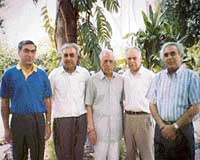My son’s teacher
by Punam Khaira Sidhu
WHAT’S up”, queried my husband when he found me desperately rifling through yellowing papers. “I’m trying to find my degree certificates and medals”. I responded. The last time I presented them for scrutiny was when I took the Civil Services exams, 17 years ago. Now, my qualifications and competence were again on test. Only this time, it wasn’t the mandarins at the UPSC, doing the assessment: it was my 10-year-old son!
It all started rather innocently. My son was doing a routine homework assignment when I corrected the spelling of accessaries to accessories and rhynoceros to rhinoceros and pointed out that ships were not parked in a harbour, but anchored in it. The little man took umbrage, and argued, “Look, my teacher’s marked it correct in my written work”. The complete conviction in his teacher being correct and complete lack of confidence in his mother’s erudition, or rather the lack of it, was a fell blow for my self-esteem.
Every time I checked an error in spelling or fact I found myself having to substantiate it with encyclopaedia and dictionaries. I would spend evenings helping him prepare a chart with diagrams et al but, when it did not meet with his teachers’ approval, my proficiency rating plummeted. That was what had me rummaging for my degrees. Junior needed to know that his mom had gone to school too and obtained a first class first Masters degree.
The student-teacher relationship, the guru-shishya parampara, is special and has been down the ages. It has to do with the aura every child invests his teacher with. The teacher is the “significant other”, the “Guru, tutor, instructor and coach”, in every little-one’s school world. The one who knows it all, is the final arbiter of all that is right and wrong, and above all holds the key to the mysteries of the world. In school, of course, the teacher is God but even outside when we run into Brother, Ma’am or Sir, the traffic stops, and a hush descends on my noisy brat as he points them out with awed admiration. From that position the teacher’s words carry complete conviction, magical appeal and unrivalled powers of persuasion.
The epics tell us of Eklavya, who cut off his thumb as “dakshina” for his Guru Dronacharya even though it meant an end to his career as an archer. The same spirit, miraculously, imbues most younger students even in the present day.
When I voiced my concern about TV, I was labelled a spoilsport; the teacher organised a debate and my son was suddenly an articulate spokesman for the harmful effects of TV. Books lay gathering dust, until Ma’am directed that each boy read a book a week and write a report. Suddenly, my son was reading abridged versions of the classics and was an authority on Charles Dickens and Mark Twain. Every parent learns to cognise and appreciate that the teachers can get their little devils to write poetry, and prose, inspire frenzied research on esoteric topics, teach them to paint, and even sing in tune. They inspire them with the motto of ‘Citius, Altius, Fortius’ in sports, and infuse them with charity and capitalism when the proceeds of the School fete are used to fund scholarships for poor kids. The teacher is the miracle worker. Mom and Dad, are well, just progenitors, to be kept in good humour so they keep the pizzas and pocket money coming in.
There’s a lot of time and energy invested in teachers’ day and birthday: thoughtful cards are hand-painted and fresh flowers hand picked. Parents’ birthdays need a strident reminder and if you try and compare, there’s the gentlest rebuff, “...hey Mom I love you. Surely you don’t need a card or a bunch of old flowers to tell you that...” Well, who can argue with that except the green-eyed monster inside who feels she could use that brand of “special thoughtfulness” inspired in her progeny by his teachers.
I guess if you can’t beat them join them: so I have volunteered with my son’s school, as a substitute teacher. Perhaps I will now discover, that special ingredient, that will take me from Mom to Ma’am and absolution.

 A
A




 T
T
